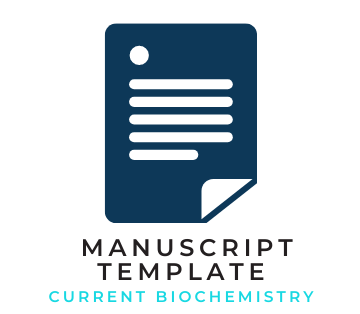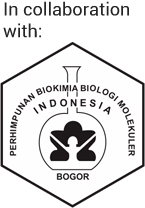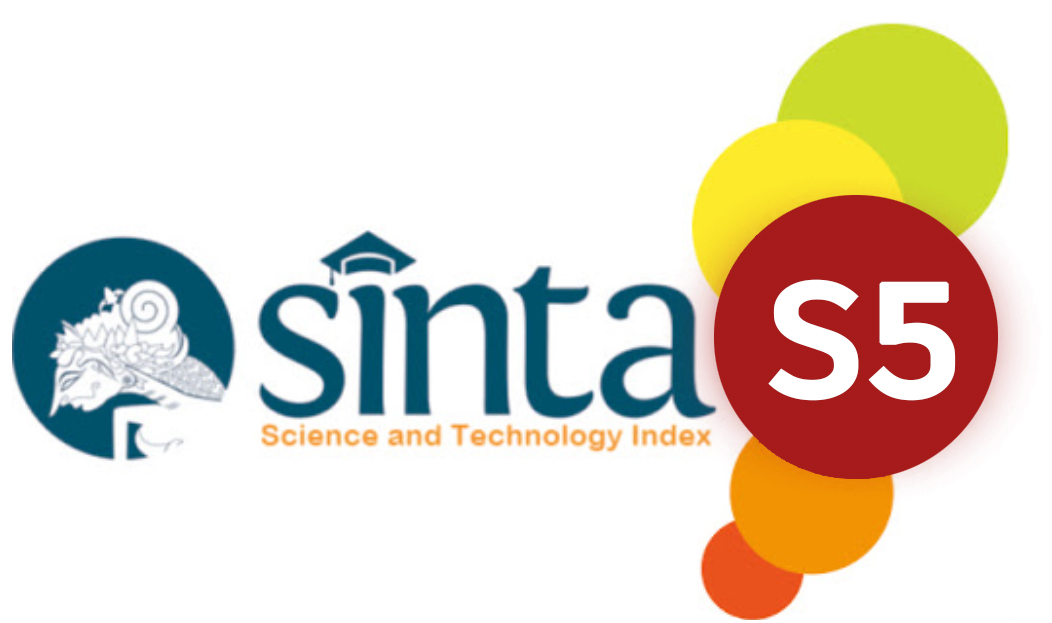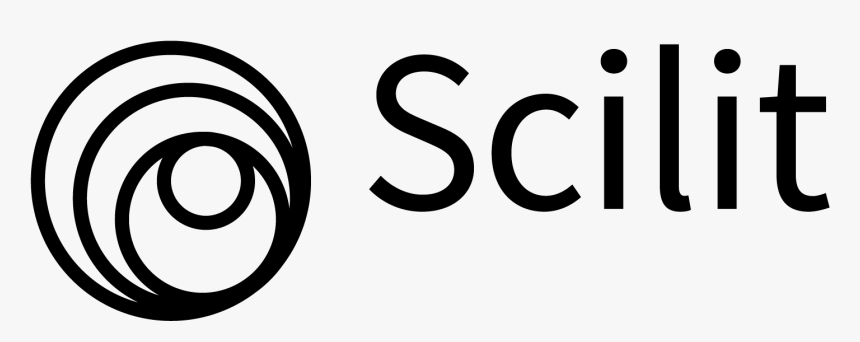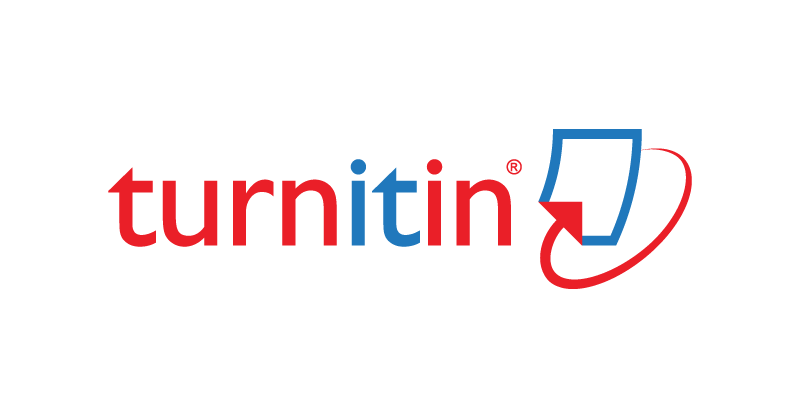AUTHOR GUIDELINE
Author Guidelines
1. Format for CB publications
Authors should mention the type of the submitted article, Research Article, Short Communication or Review Article. Click here to find the template
1.1. Research article
Research article are original and innovative reports which represent the major advance in biochemistry with deep discussion in the understanding of a significant problem. They should have no more than 50 references. Research article usually typed between 3,000 ~ 5,000 words of text (including references, note and captions) are expected to present a major advance. Experimental procedure should be given in sufficient detail to support the reports.
1.2. Short communication
Short communication are short report that presenting preliminary result with potentially exceptional relevance or giving details of new models, innovative methods, techniques or apparatus. Short communication article should be no more than 2500 words (including references, notes and captions) and must at least has 10 primary references.
1.3.Review article
Revew article are summaries of excellent scientific research articles which deal with specific research area of high interest in any area that fall under Current Biochemistry scope. Review article can be written up to 5000 words (including references, note and caption) and around 80% of references must be come from primary articles.
2. Manuscript submission
Manuscript should be written clear and simple so that they are accessible to readers in other disciplines. The decision of the publication will be notified to the authors using email or phone. Repeated submission of the same paper will not be acknowledged. All paper submission to CB will be treated as confidential documents. Our peer review process is also confidential and the identities of reviewersare not released. Authors might be asked to provide four reviewer candidates related to the research theme. CB will decide who will review the article and it is not necessary to include reviewer provided by the author. Research paper that are selected for in-depth review are evaluated by at least two outside reviewers. Reviewers are contacted before we send the documents and asked to return comments within 1 to 2 weeks. Selected papers are edited to improve accuracy and clarity and for length.
CB makes decision about accepted papers as soon as possible. All manuscript are handled electronically troughout the consideration process. Authors will be informed within a week if the paper is not being considered.
3. Manuscript format
All manuscript should by typed in 1,5 line spacing and 12 point of Times New Roman font in A4 paper with margins 2,5 cm on all four sides. Use line numbers for all manuscript. Page numbers should be located at the right bottom. Tables and figures supporting the reports must be grouped and placed at the end of the manuscript (after the references). Manuscript should be between 9 – 15 pages (including tables and figures).We only receive digital file of the manuscript (word file), authors must ensure that the PC used to write the manuscript is free of virus. All manuscript (research article and short communication) should be divided into the following headings:
- Title page
- Author’s information
- Abstract
- Keywords
- Introduction
- Methodology
- Results
- Discussion
- Acknowledgement
- References
- Tables
- Figures
Format for review article is the same as research article except “materials and methods” and “results” were replaced with “Review”.
3.1. Title Page
The title page should include complete manuscript title (no more than 15 words) and a short title which will be used as a “running head”. Short title should not exceed 60 characters including space. The title must be written in English and Bahasa if your manuscripts are in Bahasa.
3.2. Authors information
Authors information must include full name of each author (without title), the present address and department and institution in which the work was conducted. Add phone, fax numbers and E-mail address for the correspondence author.
3.3. Abstract
For original articles and new methods submissions, a structured abstract of no more than 250 words should use all of the following headings: Aim of the study, Material and Methods, Results and Conclusion. Author must avoid the use of abbreviation, acronym or measurement unless it is essential. Editor has the right to edit the abstract to improve the clarity.Please define abstract in two version languages (Bahasa and English versions) if the article(s) was in Bahasa.
3.4. Keywords
Author must provide 3 to 5 keyword written alphabetically.
3.5. Introduction
State the objectives of the study and provide an adequate background, avoiding a detailed literature survey or to describe the results.
3.6. Methods
Methods should include relevant details on the materials and experimental design and techniques so that the experiments can be repeated. Names of products and manufacturers should be included only if alternate sources are deemed unsatisfactory. Novel experimental should be described in detail. If previous researcher method is used, please describe briefly that method and describe in detail if you make any modification to the procedure.
3.7.Results
These should be presented precisely without discussion of their importance. Do not duplicate information contained in tables and figures. Result must not contain any references.
3.8. Discussion
This should directly relate to the results of the study. Do not provide a general review of the topic. A conclusion at the end this section should be added
3.9. Acknowledgement
Acknowledgements should be made only to those who have made a substantial contribution to the study. Authors are responsible for obtaining written permission from people acknowledged by name in case readers infer their endorsement of data and conclusions.
3.10. References
Refrences only list the published or accepted material for publication and should be at least 80% primary references (journal articles). Accepted article(s) but not yet published should be sent as manuscript appendix.
Current Biochemistry follows the American Psychological Association 7th edition style and should be using Mendeley References Manager. All works included in the reference section should be referred to the text. They should be referred to the text by the name(s) of the first author and the year of publication in parentheses, using following format:
(Nelson and Cox, 2005) or Nelson and Cox (2005). If the authors is more than two, use the first author’s lastname and add “et al.”. the order for the references within parentheses in the text should be typed start from the oldest year (Günzler and Williams, 2008; Rubinoff and Sperling, 2021; Marliani et al., 2022;). If the references have the same year, place them alphabetically. For works by the same author(s) in the same year, append a lowercase a, b, c, etc. to the year of publication.
The reference list should follow these styles:
- Journal article
Marliani, N., Artika, I. M., Rafi, M., Syukur, M., Galinngging, R. Y., & Nurcholis, W. (2022). Phenolic and flavonoid content with agro morphological characters of 12 accessions of Justica gendarussa grew in Indonesia. Biodiversitas Journal of Biological Diversity, 23(10). https://doi.org/10.13057/biodiv/d231017
- Book
Artika, I. M., Safithri, M., & Dwicesaria, M. A. (2025). Menguak Misteri Biokimia: Struktur dan Fungsi Seluler. IPB Press.
- Chapter in a book
Mishra, S. K., Singh, R., Chang, H.-M., Obaid, A. A., & Singh, S. K. (2025). Biomarkers used in Alzheimer’s disease diagnosis. In A New Era in Alzheimer’ s Research (pp. 31–50). Elsevier. https://doi.org/10.1016/B978-0-443-15540-6.00013-6
- Thesis or Dissertation
Dwicesaria, M. A. (2023). Analisis Kandungan Fraksi Phomopsis sp. dari Daun Sirsak sebagai Antiproliferasi dan Apoptosis Sel Kanker Payudara MCF-7. Institut Pertanian Bogor.
- Internet
Menon, G., Alkabban, F. M., & Ferguson, T. (2024). Breast Cancer. https://www.ncbi.nlm.nih.gov/books/NBK482286/
- Proceeding/Prosiding
Nandi, Ismail, J. R., & Ismail, A. (2024). Spatial analysis on influence of elevation to coronavirus disease-19 infection fatality ratio in Bandung Regency and Bandung City. IOP Conference Series: Earth and Environmental Science.
3.11. Tables
These should be typewritten, single-spaced, each one on a separate page and numbered consecutively in Arabic numerals. Tables should include a short but concise title. Vertical and horizontal lines should be avoided in the tables. Place explanatory matter in footnotes, including any non-standard abbreviation. If data from another published or unpublished source are used, obtain permission and acknowledge fully. Numbers and table title are written in 10 point Times New Roman font.
3.12. Figures
Submit each figure as a separate file and in TIFF or EPS format with a resolution of at least 300 dpi. Number figures consecutively using Arabic numerals. Submit photographs scaled as near to printed size as possible. Arrows should be given to point certain objects. If magnification is significant, indicate using a bar on the print rather than a magnification factor in the figure legend (see “10. Example”). Give each figure a legend containing sufficient information to make the figure intelligible without the reader having to refer to the text. Key all the legends together. If a figure has been published previously, acknowledge the original source and submit written permission from the copyright holder to reproduce it.
3.13. Statistical graphs
Give standard deviation to every mean value. Authors that used Microsoft Excell Program need to give the raw data.
4. Abbreviations and Units
Generally, units must be abbreviated according to the International System of Units (SI units: http://www.bipm.org/en/home/). It is important to maintain the capital letters and lower case letters as they appear in the abbreviation to avoid confusion with other abbreviations. In devising such abbreviations and symbols, the recommendations of the Nomenclature Committee of IUBMB and the IUPAC-IUBMB Joint Commission on Biochemical Nomenclature (see http://www.chem.qmul.ac.uk/iubmb/) should be followed as far as practicable.
5. Proof reading
CB will send the proof to correspondence author by email. Author should do proof reading carefully and send the corrected proof to CB in three working days.
6. Manuscript submission
We use an online manuscript submission and tracking system. in order to submit, you must have registered for an account for Current Biochemistry journal. go to the home page and register an account or https://journal.ipb.ac.id/index.php/cbj/user/register . After this, please consult the following instrutions for article submission.
7. Publication Charges
Current Biochemistry welcomes article submissions and does not charge Article Processing Charges (APCs) and Article Publication Fee (Free). Readers can read and download any full-text articles free of charge. For Libraries/Individual, can read and download any full-text articles for free of charge.
Article Submission: 0.00 (USD)
Authors are not required to pay an Article Submission Fee as part of the submission process to contribute to review costs.
Article Publication Charges (APCs): 0.00 (USD)
For Libraries/Individuals, can read and download any full-text articles for free of charge.
8. Author List
During manuscript submission, the submitting author must provide contact information (full name, email address, institutional affiliation and mailing address) for all of the co-authors. The author who submits the manuscript for publication accepts the responsibility of notifying all co-authors that the manuscript is being submitted. Deletion of an author after the manuscript has been submitted requires a confirming letter to the Editor-in-Chief from the author whose name is being deleted.
Upon submission, Editor in Chief will assign the manuscript to a corresponding Editor for further handling. The Editor will request at least two scientists to review the manuscript. Based on the comments from the reviewers, Editor, and Editor-in-Chief will make the decision on the manuscript.
Authors should review the preparation of the manuscripts prior to submission of a manuscript. Close attention to all the required details in preparation of the manuscripts will expedite review and reduce the time to publication.
9. Journal Publishing Agreement
A properly completed and signed Journal Publishing Agreement must be submitted for each manuscript. Authors must signed the agreement stating that the submitted article have never been published on another Journal.
10. Example
Please, find the full Guideline (with example) in this attachment.

